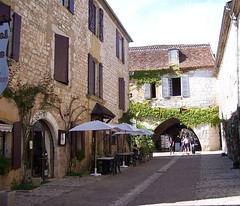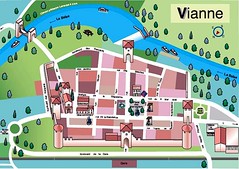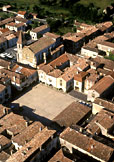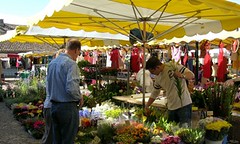Vive les bastides - medieval planned communities

Posted February 12, 2008 at 5:40PM
 Smart growth has many, many historical precedents. Think New England’s classic villages or, here in the DC area, Georgetown, Old Town Alexandria, and the core of Annapolis. Andres Duany’s first efforts were called “traditional neighborhood development” for a reason.
Smart growth has many, many historical precedents. Think New England’s classic villages or, here in the DC area, Georgetown, Old Town Alexandria, and the core of Annapolis. Andres Duany’s first efforts were called “traditional neighborhood development” for a reason.
At last week’s national smart growth conference, I was treated to a terrific impromptu slide show by Steve Tracy of the Local Government Commission. Steve has recently toured some of the most beautiful and interesting of these precursors to smart growth, the bastides of southwestern France. One of them, Monpazier, is shown in the photos accompanying this post.
These beautiful villages, many of them in the Dordogne valley, were pretty advanced for their day. They were typically built not on the meandering alleys of many medieval towns but, instead, on an orderly grid pattern, with multiple ways to get from one place in the community to another.  They had a public center, generally a market square, ringed by arcades to shade walkers from the hot summer sun. The market itself was frequently sheltered as well. The community’s church was usually just off the center. And, generally speaking, a 10-minute walk would get you to the center from any part of the village. Note the site plan for Vianne, which looks like it could have been lifted right out of the new urbanist handbook. This is neighborhood smart growth in a nutshell.
They had a public center, generally a market square, ringed by arcades to shade walkers from the hot summer sun. The market itself was frequently sheltered as well. The community’s church was usually just off the center. And, generally speaking, a 10-minute walk would get you to the center from any part of the village. Note the site plan for Vianne, which looks like it could have been lifted right out of the new urbanist handbook. This is neighborhood smart growth in a nutshell.
On the not-so-good side, they were also precursors to today’s gated McMansion subdivisions, since many of them had walls to prevent the intrusion of unwanted invaders, generally the English or the French, depending on which part of the country you were in and when.
 Over 300 bastides were built over a 150-year period from the early 1200s, most quite by plan. They were a way of claiming and defending territory. Settlers were induced to live in them by the gift of a homestead inside the boundary, and a plot of land to farm outside. The settlers also became free of certain taxes and restrictions, such as those previously paid for marriage of a daughter or sending a son to seminary. The grid pattern simplified the organization of the town, dividing it into roughly equal parcels which, in turn, simplified assessment and collection of the remaining taxes. All this was fairly progressive for the day, and played a role in the ending of the medieval feudal system.
Over 300 bastides were built over a 150-year period from the early 1200s, most quite by plan. They were a way of claiming and defending territory. Settlers were induced to live in them by the gift of a homestead inside the boundary, and a plot of land to farm outside. The settlers also became free of certain taxes and restrictions, such as those previously paid for marriage of a daughter or sending a son to seminary. The grid pattern simplified the organization of the town, dividing it into roughly equal parcels which, in turn, simplified assessment and collection of the remaining taxes. All this was fairly progressive for the day, and played a role in the ending of the medieval feudal system.
Then, as now, people in walkable communities had a better deal in many ways than people who don’t. Note how well the market square is still functioning on market days, over seven centuries later. Now that’s sustainability.
 So I’m now thinking this might be just the place for my next cycling vacation. In fact, while researching this post, I also discovered that Bastide is the name of a trendy restaurant in Los Angeles. I want to go there too. I’ll have to look at NRDC's (miniscule) smart growth budget; I don’t think these trips match up with any line items in there, but it is all for the cause.
So I’m now thinking this might be just the place for my next cycling vacation. In fact, while researching this post, I also discovered that Bastide is the name of a trendy restaurant in Los Angeles. I want to go there too. I’ll have to look at NRDC's (miniscule) smart growth budget; I don’t think these trips match up with any line items in there, but it is all for the cause.
Finally, as an aside, presidential election dropout Mitt Romney seems to find it an alarming prospect that the US “could become the France of the 21st century.” I think he meant it negatively. Now why do I think he’s engaging in jingoistic manipulative politics? He wouldn’t do that, would he? Art, wine, cheese, history and a strong economy sure beat endless traffic jams, fast food joints, and being a bullying warmonger on the world stage in my book, but maybe that’s just me.